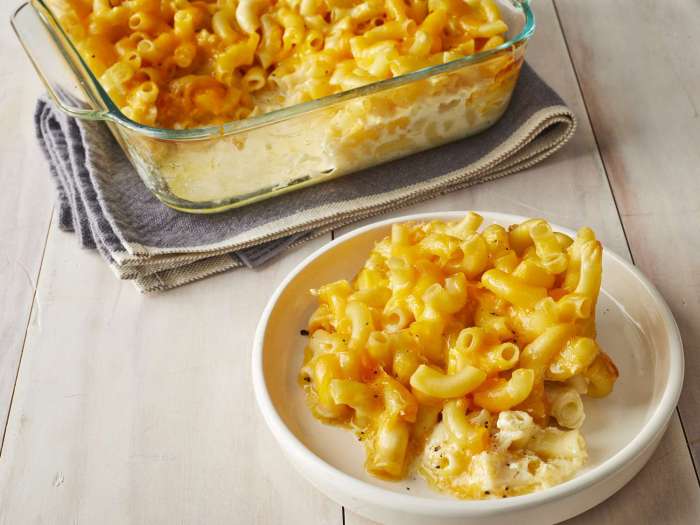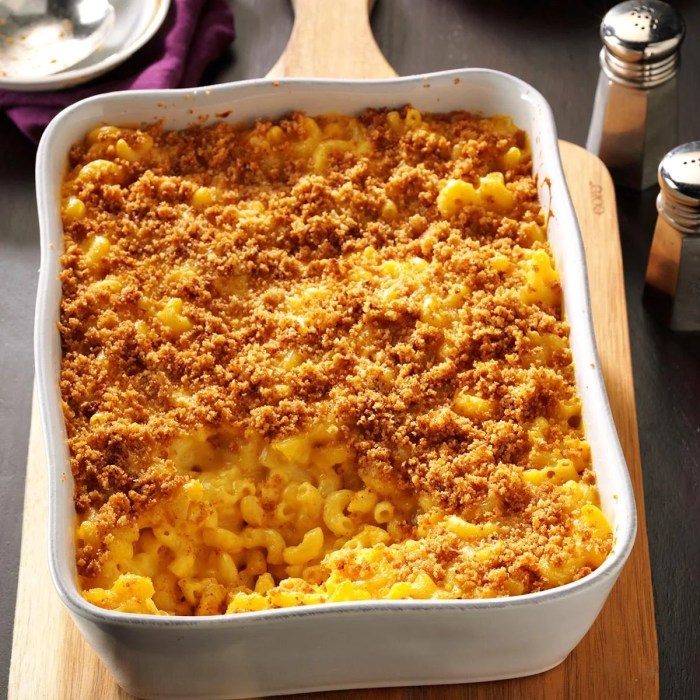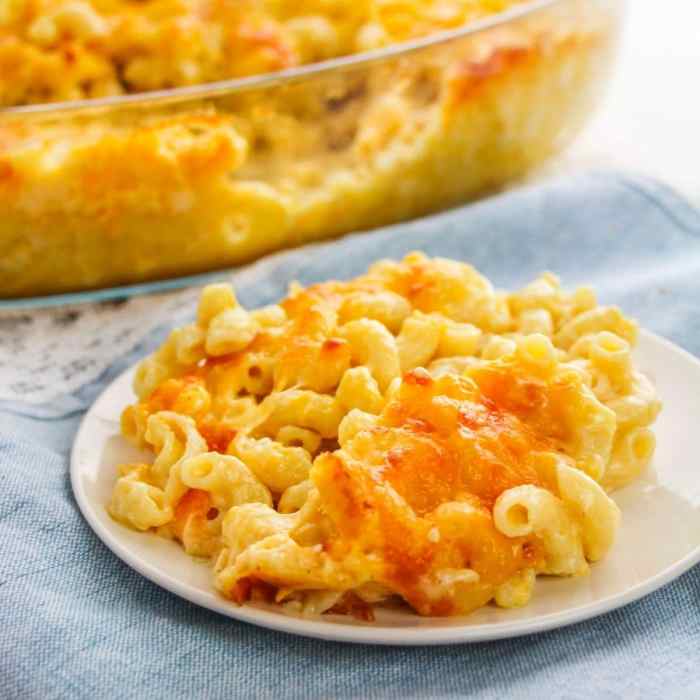Baked Mac Cheese Sauce Recipe A Creamy Guide
Baked Mac and Cheese Sauce: A Creamy Dream: Baked Mac Cheese Sauce Recipe
Baked mac cheese sauce recipe – Baked mac and cheese, a comforting classic, transcends simple pasta and cheese. Its appeal lies in the rich, creamy sauce, the perfectly cooked pasta, and the satisfyingly browned top. A dish enjoyed across cultures and generations, its evolution reflects culinary innovation and regional preferences.
Introduction to Baked Mac and Cheese Sauce
Baked mac and cheese is a beloved dish for its creamy texture, cheesy flavor, and satisfyingly comforting nature. While its exact origins are debated, variations of cheese-sauced pasta have existed for centuries. The baked version, however, is thought to have gained popularity in the United States during the 20th century, becoming a staple of potlucks and family dinners. The dish’s versatility allows for countless adaptations.
Three popular variations include:
- Spicy Jalapeño Mac and Cheese: Adds diced jalapeños and a dash of cayenne pepper for a fiery kick.
- Four-Cheese Mac and Cheese: Incorporates cheddar, Gruyère, Parmesan, and Fontina for a complex and nuanced flavor profile.
- Lobster Mac and Cheese: Elevate the classic with chunks of cooked lobster meat for a luxurious twist.
Essential Ingredients for a Creamy Sauce

Source: onecms.io
Creating a truly exceptional mac and cheese sauce hinges on the right ingredients. The cheese selection is paramount, contributing unique flavors and textures.
Five essential cheese types include:
- Cheddar: Provides a sharp, tangy base.
- Gruyère: Offers a nutty, slightly sweet flavor.
- Parmesan: Adds a salty, umami depth.
- Fontina: Contributes a creamy, melt-able quality.
- Mozzarella: Provides stretch and adds a mild, milky flavor.
Milk or cream plays a vital role in achieving the desired creamy texture and acts as a vehicle for the cheese to melt smoothly. Flour or cornstarch serves as a thickening agent, creating a luscious sauce that coats the pasta evenly.
| Milk Option | Fat Content (%) | Impact on Sauce Texture | Notes |
|---|---|---|---|
| Whole Milk | ~3.25 | Moderately creamy | Good balance of creaminess and lightness |
| Half-and-Half | ~10-18 | Creamier, richer | Adds more richness without being overly heavy |
| Heavy Cream | ~36 | Very rich, decadent | Best for ultra-creamy, luxurious mac and cheese |
Methods for Preparing the Cheese Sauce
Two primary methods exist for crafting the perfect cheese sauce: the roux-based and the béchamel-based approaches. Both yield delicious results, but offer subtle differences in taste and texture.
The roux method involves cooking butter and flour together to create a roux, then gradually whisking in milk or cream and cheese. The béchamel method starts with a classic béchamel sauce (butter, flour, milk), before adding cheese. Low heat is crucial to prevent scorching and ensure a smooth, lump-free sauce. Consistent whisking prevents lumps.
The roux method generally results in a slightly thicker sauce with a richer flavor due to the toasting of the flour. The béchamel method often produces a lighter, more delicate sauce.
Pasta Selection and Preparation

Source: tmbi.com
Choosing the right pasta is essential for optimal baked mac and cheese. Elbow macaroni is a classic choice, but other shapes work equally well. Cooking pasta al dente ensures it holds its shape and texture after baking.
Tips for perfectly cooked pasta:
- Use plenty of salted boiling water.
- Cook until al dente, about 2 minutes less than package directions.
- Drain thoroughly to remove excess water.
Thorough draining is crucial to prevent a watery sauce.
- Elbow macaroni: Classic choice, good for holding sauce.
- Cavatappi: Spiral shape, captures more sauce.
- Shells: Larger shells hold a generous amount of filling.
- Penne: Slightly larger than elbow macaroni, with a good sauce-to-pasta ratio.
Baking the Mac and Cheese

Source: crayonsandcravings.com
Baking the mac and cheese completes the transformation, creating a golden-brown crust and melting the cheese to perfection. A breadcrumb or cracker topping adds texture and enhances the browning process.
Ideal baking temperature is 375°F (190°C) for approximately 20-25 minutes, or until golden brown and bubbly. Assemble the mac and cheese in a greased baking dish, spreading evenly. A topping of breadcrumbs, crushed crackers, or panko adds textural contrast and a crispy finish.
Recipe variation: Use panko breadcrumbs for a crispier topping, or crushed potato chips for a salty, savory crunch.
Recipe Variations and Add-ins, Baked mac cheese sauce recipe
The beauty of mac and cheese lies in its adaptability. Adding vegetables, meats, or spices creates entirely new flavor profiles.
Three mac and cheese variations:
- Broccoli Cheddar Mac and Cheese: Adds steamed broccoli florets for a healthy twist.
- Bacon and Caramelized Onion Mac and Cheese: Incorporates crispy bacon and sweet caramelized onions for a savory combination.
- Buffalo Chicken Mac and Cheese: Features shredded chicken tossed in buffalo wing sauce for a spicy, tangy dish.
| Add-in | Flavor Profile | Texture Impact | Notes |
|---|---|---|---|
| Broccoli | Earthy, slightly sweet | Adds a slight vegetal crunch | Steam broccoli until tender-crisp |
| Bacon | Salty, smoky | Adds a crispy texture | Cook bacon until crispy, then crumble |
| Buffalo Chicken | Spicy, tangy | Adds moist, tender chicken | Use pre-cooked or rotisserie chicken |
Different add-ins impact the overall texture. Vegetables add a slight crunch, while meats introduce variations in moisture and texture.
Serving and Storage Suggestions
Baked mac and cheese is best served hot, straight from the oven. Leftovers can be stored in an airtight container in the refrigerator for up to 3 days. Reheating can be accomplished in the oven, microwave, or on the stovetop, ensuring the mac and cheese remains moist and creamy.
To prevent dryness when reheating, add a splash of milk or cream before reheating.
Essential Questionnaire
Can I use pre-shredded cheese?
While convenient, pre-shredded cheese often contains cellulose which can prevent proper melting and create a grainy texture. Freshly grated cheese is recommended for the best results.
What happens if I overcook the sauce?
Overcooked sauce can become thick and gummy. Stir frequently over low heat to prevent scorching and ensure even cooking.
How can I make my mac and cheese extra cheesy?
Increase the amount of cheese in the recipe, or add a stronger cheese such as Gruyere or Fontina for a more intense flavor.
Can I make this ahead of time?
Yes, the mac and cheese can be assembled ahead of time and refrigerated. Add an extra 10-15 minutes to the baking time when baking from cold.





















